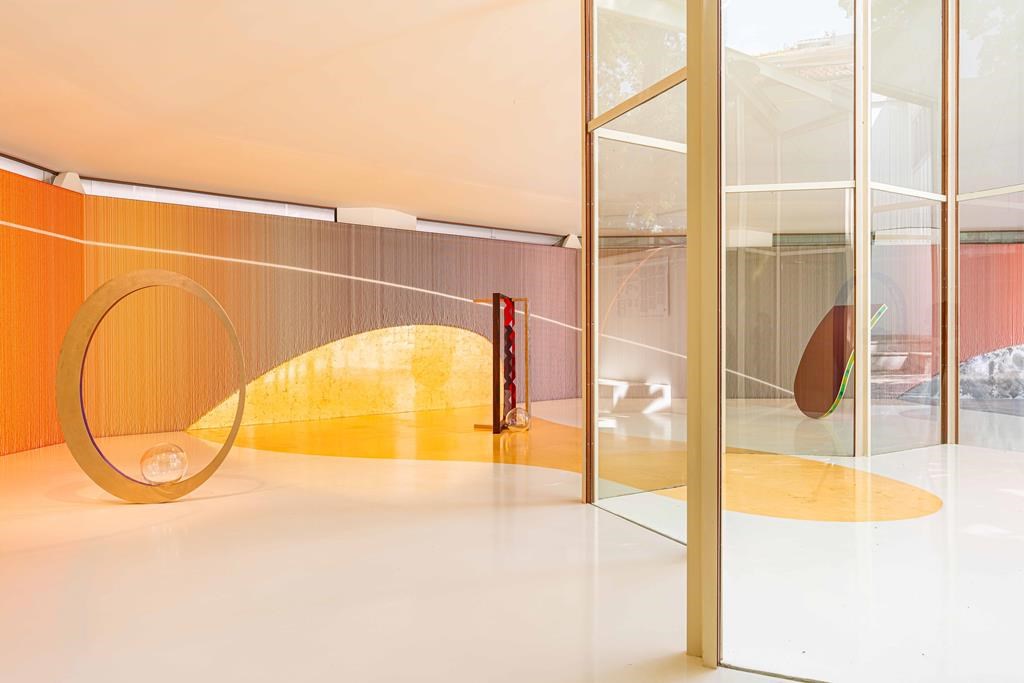


Hundreds of thousands of tiny glass beads will soon be twinkling in the sun across the entire Canadian pavilion at the Venice Biennale, Canada’s newly revealed entry in one of the world’s most prestigious art fairs.
But Kapwani Kiwanga, the Hamilton-born, Paris-based creator of the work, wants you to get past the cobalt blue glass glinting in the Venetian light. She wants you to think of each bead as a character.
“The materials are documents of themselves,” she says. “They’re witnesses.”
The beads used in her installation “Trinket” were made on the nearby Venetian island of Murano. Centuries ago, similar beads were used all over the world as both desirable trade goods and currency in themselves.
Their name, “conterie,” comes from the Portuguese word for “count.”
“I never use (materials) just because they’re esthetically pleasing,” Kiwanga says. “That comes into it at one point but it’s really their social, cultural and economic history that makes me want to settle on a material.”
Kiwanga’s installation at the Canada Pavilion was revealed Tuesday, more than a year after she was named Canada’s representative to the 60th Venice Biennale.
Kiwanga has previously installed works at art galleries and fairs from Saskatoon to Dublin and London to Istanbul.
She has won major art prizes in Canada and France, and bagged nominations from the British Academy of Film and Television Arts for her film work.
Throughout all that work, she says, runs her interest in what materials have to say for themselves.
Sometimes, plants do the talking. One of her previous installations, “Flowers for Africa,” uses familiar flowers like gladioli that originated in Africa.
They may look arranged for a posh wedding or upscale hotel lobby, but are recreations of flower arrangements created for diplomatic events linked to independence negotiations for African countries. The arrangements gradually wilted, evoking emotions about the passage of time and the fleeting nature of pomp.
In other works, colours speak to the audience.
“Linear Paintings” explores hues believed to promote certain moods and used by industrial designers to cover walls in offices, mental health hospitals and prisons.
“I’m thinking of them as characters who have witnessed a past event,” Kiwanga says. “History is a starting point for a lot of my work, although I’m thinking about our present and sometimes our future as well.
“My larger question or interest is power and power dynamics.”
She wants viewers to consider her work a kind of “gateway.”
“I’m not trying to prove anything. I’m not looking for materials that prove a point. I’m just saying the who or the how or the what,” she says.
The work begins with a vague notion of something interesting that sheds a bit of light on how the world operates.
Then it’s study time. Popular and academic works on the theme are consulted, experts are interviewed, archives combed. She says about 60 per cent of the work needed to create a new piece is done in the library, not the studio.
Kiwanga credits her anthropology degree from McGill University with giving her the research skills necessary to her artistic practice.
For her sense of the world, she gives some credit to Hamilton. She now divides her time between Canada, France and Tanzania, but it was Steeltown that first showed her the world is a big place.
“Growing up in downtown Hamilton was quite diverse,” she says.
“In my Grade 1 class — I remember this — we had people from all over the world, some of whom had just arrived. The world already was in this tiny little bit of my reality.”
Being chosen to represent Canada at the nearly 130-year-old Venice Biennale “was a great honour,” she said.
Canada has been represented at the art fair since 1952. This year’s version will see 63 countries participating.
Previous Canadian representatives have included illustrious artists such as Alex Colville, Michael Snow and Stan Douglas — and that creates a certain pressure, Kiwanga admits.
“One person is chosen every two years, but there are so many other artists who could have been chosen and done something amazing. I felt a responsibility.”
But just being part of a global art conversation will be a highlight, Kiwanga says. And true to form, she’s already thinking of the Biennale as another kind of document.
“When we’re all together and we end up finishing our works, what’s it going to say about this moment?”
The Venice Biennale international art exhibition runs from April 20 to Nov. 24.
This report by The Canadian Press was first published April 16, 2024.
Bob Weber, The Canadian Press